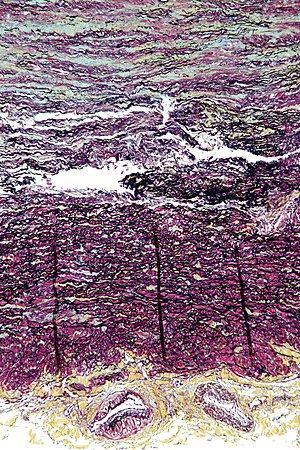Cystic medial necrosis
| Familial thoracic aortic aneurysm | |
|---|---|
 |
|
| Micrograph showing cystic medial degeneration, the histologic correlate of familial thoracic aortic aneurysms. The image shows abundant basophilic ground substance in the tunica media (blue at top of image) and disruption of the elastic fibers. The tunica adventitia (yellow at bottom of image) with vaso vasorum is also seen. Movat's stain. | |
| Classification and external resources | |
| ICD-9-CM | 441.00 |
| OMIM | 607086 |
| DiseasesDB | 30073 |
| eMedicine | emerg/28 |
Familial thoracic aortic aneurysm (also referred to as familial aortic dissection or cystic medial necrosis of aorta) is an autosomal dominant disorder of large arteries.
There is an association between familial thoracic aortic aneurysm, Marfan syndrome and massive baclofen overdose as well as other hereditary connective tissue disorders.
A degenerative breakdown of collagen, elastin, and smooth muscle caused by aging contributes to weakening of the wall of the artery.
In the aorta, this can result in the formation of a fusiform aneurysm. There is also increased risk of aortic dissection.
Types include:
It is sometimes called "Erdheim cystic medial necrosis of aorta", after Jakob Erdheim.
The term "cystic medial degeneration" is sometimes used instead of "cystic medial necrosis", because necrosis is not always found.
...
Wikipedia
